Can, Store, Dry, Freeze, Pickle and Then Eat Well
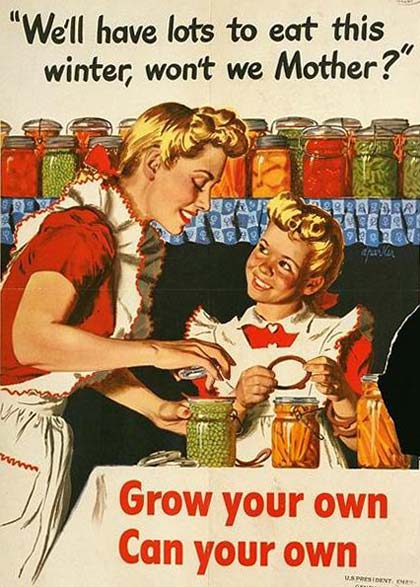 Food preservation played a big role in nutrition programs during the war. Mother & daughter canning poster courtesy Northwestern University Library
Food preservation played a big role in nutrition programs during the war. Mother & daughter canning poster courtesy Northwestern University Library
Farm labor shortages, localized food surpluses from Victory Gardens, and rationing of many types of food dovetailed to heighten the importance of nutrition programs to the war effort. Nutrition programs sought to use available foods more efficiently, through reduction of waste, preservation, and other means so
more food would be available for the battle fronts and for allies. If successful, the program would require that much less from overworked farmers and commercial canners, while it would make sure that extra Victory Garden produce would find its way to local canning circles and reduce demand for scarce rationed food products. Certainly from a nutritional standpoint, healthy well-fed Americans would maintain a higher morale, be more productive, and miss less work because of illness. So, as with many other aspects of wartime life, good nutrition was promoted as every American's patriotic duty.
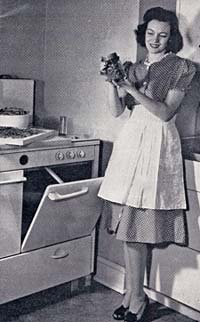 A woman shows off a jar of canned beans. (Folder 18, Box 28, Defense Council, OSA)
A woman shows off a jar of canned beans. (Folder 18, Box 28, Defense Council, OSA)
The Oregon State Defense Council formed a State Nutrition Committee in 1941 to plan and promote nutrition efforts in the state. Chaired by the indefatigable Ava Milam, Dean of the Home Economics Department at Oregon State College in Corvallis, the committee was comprised of leading experts in the fields of nutrition, health
and agriculture. Counties also formed nutrition committees to put the program in motion on the local level. The State Nutrition Committee acted as a conduit for information from
federal agencies to the county committees and also coordinated statewide activities. Over time state and local program volunteers were
involved in teaching nutrition courses, putting on food demonstrations, displaying nutrition exhibits, talking to civic and service groups, participating in radio programs, promoting school lunches, and taking part in national nutrition campaigns.
Food Preservation
Reduction of food waste was a national goal that nutrition committees in Oregon promoted through various forms of food preservation. Dean Milam led the cheerleading by
saying
"every individual homemaker in Oregon can help in the nutrition for defense program by canning, freezing, drying, and storing every bit of fruit, vegetables, and other foods that she can obtain and process." According to Milam, liberal interpretation of sugar rationing rules allowed fruit canners to use all the sugar needed up to a ratio of one pound of sugar to four quarts of fruit. She put canning in the context of the war effort: "If surplus fruit is going to waste or is easily available, it is not only the right but the patriotic duty of homemakers to obtain more canning sugar if necessary and put up more food for future use." This would not only "help Uncle Sam but help ourselves to meet the food budget problems for the coming months."
Footnote 1
In another missive to homemakers, Milam promoted the formation of "canning circles" to best utilize resources because "though the first peas are just beginning to poke their heads through the sodden soil, Victory gardeners are looking forward to the harvest and the problem of canning, drying and freezing surpluses." She implored people who owned pressure canners to share them with other families since "only a few canners will be available for purchase this year." Milam suggested six or more families share each cooker and even share the preparation of the fruits and vegetables for canning since "many hands make light work."
Footnote 2
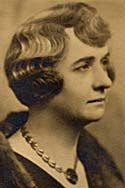 Ava Milam chaired the State Nutrition Committee. (Photographs, Defense Council, OSA)
Ava Milam chaired the State Nutrition Committee. (Photographs, Defense Council, OSA)
The federal Department of Agriculture promoted the value of canning and recognized the shortage of pressure cookers. In 1943 the department convinced another federal office to allocate more material to manufacture "a number of family size cookers, 7-quart capacity, which will be sold through the regular retail outlets." Still, would-be purchasers needed to fill out Form MR20A and submit it to their local county farm rationing board, which, if approving,
would issue a purchase certificate--few things were simple in the wartime economy.
 Nutrition newsletterFootnote 3
Nutrition newsletterFootnote 3
For those tempted to skip the bureaucracy and proceed without the proper equipment, nutrition experts warned against "canning any vegetables other than tomatoes without using a pressure cooker, for danger of food spoilage and possible poisoning."
Footnote 4
Several other methods of food preservation
were available to gardeners. Simply storing vegetables in basements, root cellars, or appropriate outdoor settings could be a cheap and easy solution. This worked for any "under-the-ground" vegetable
such as onions and potatoes but also worked for apples, squash
and pumpkins. Some variations existed for optimum storage. For example, potatoes kept best between 40 and 50 degrees Fahrenheit while sweet potatoes did better between 55 and 60 degrees. Smart food storers could tailor the precise storage location of different fruits and vegetables according to their individual needs. But they were forewarned: "Turnips should not be placed in the basement as they give off odors that penetrate through the house."
Footnote 5
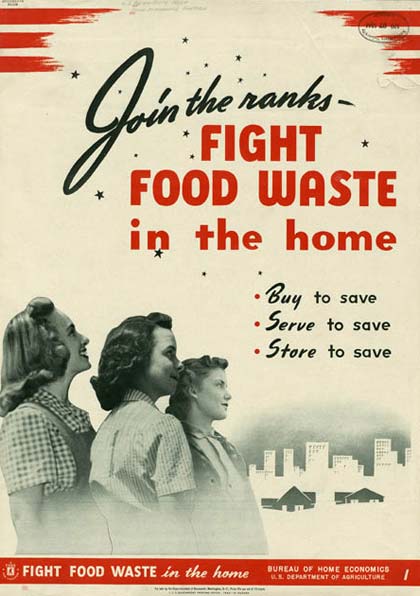 Keen thinking while buying, serving, and storing food would avoid
waste. Fight food waste graphic courtesy Northwestern University Library
Keen thinking while buying, serving, and storing food would avoid
waste. Fight food waste graphic courtesy Northwestern University Library
Three other food preservation methods also proved popular. Officials promoted home drying of fruits and vegetables as patriotic "because it requires neither sugar nor the metals, rubber, or other scarce materials used in more common types of food preservation."
Moreover, since vegetables were precooked before drying, they could be cooked for the table quickly. Wartime had a different effect on pickling as a means of preservation according to one Victory Garden book. Because some pickling ingredients could be in short supply, "sweet pickles may not be so sweet, nor spiced pickles so spicy" as prewar versions. Another government publication trumpeted that the "newest method of preserving foods is by quick-freezing. Many families throughout the country are now renting lockers at quick-freezing plants for storing their own vegetables, fruits, meats and poultry."
Footnote 6
Nutrition Education
In addition to
promoting
food preservation, officials
provided information on other nutrition subjects. For example, homemakers were told
it was a waste to improperly prepare foods since "much of the vitamin value...can be lost en route to the dinner plate." Experts advised that most vegetables should be served raw when possible or cooked rapidly and "only until tender." Along with saving the vitamins needed for good nutrition, proper food preparation would also preserve the "fresh color, flavor, and texture" of the vegetables, thereby making the cook more popular in the dining room.
Footnote 7
Experts also advised that homemakers carefully plan their meals to combine food groups into the most nutritious meals. Under the slogan "U.S. Needs US Strong--Eat the Basic 7 Every Day," government officials promoted the seven food groups that they thought should be in every daily diet. Each group corresponded with a color to make it easy to remember. Thus, white was for milk and milk products, brown was for breads and cereals, and green was assigned to green and yellow vegetables. The less understandable color choice of blue was apparently a catch-all assigned to "potatoes and other fruits and vegetables."
Footnote 8
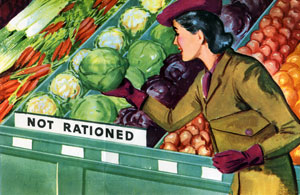 Shoppers were encouraged to buy nutritious foods, especially fruits and vegetables since they weren't rationed. (Folder 5, Box 28, Defense Council, OSA)
Shoppers were encouraged to buy nutritious foods, especially fruits and vegetables since they weren't rationed. (Folder 5, Box 28, Defense Council, OSA)
Representatives of nutrition committees went into local communities to gather information and educate residents. One committee focused on people living around the campuses of state colleges. For example, the Campus Nutrition Committee surveyed 53 Oregon State College campus living organizations and found deficiencies. Boarding houses and dormitories were not using enough enriched flour and bread and lacked enough raw fruits and vegetables, but seemed to have adequate meat and milk purchases. Armed with the results of the survey, members met with fraternity managers as well as "all housemothers and hostesses of sororities and women's cooperatives" to "explain the pattern for good nutrition in choice of diet and to assist them with any specific problems." Officials also met with 60 boarding house representatives, distributed "Eat the Right Food" posters, secured the promise of the publication of nutrition stories in the Barometer student newspaper, and distributed nutrition pamphlets.
Footnote 9
The State Nutrition Committee also made recommendations to hotels and restaurants. Among the suggestions was to highlight "protective" or nutritious foods on the menu, "perhaps in bold-face type or featured with a notation at the bottom that these are protective foods." The committee pressed restaurants to include educational information on the back of the menu that described nutritious foods to be included in the daily diet or gave advice on how to cook vegetables. Among other things, restaurateurs were asked to give diners the choice of tea, coffee, or milk with their meals, to use raw vegetables as garnish, and to cook vegetables in small quantities "so as to avoid holding on the steam table." No record appears to have been made of how many hotels and restaurants went along with the recommendations.
Footnote 10
Promotional Efforts
Officials used media to get the word out about nutrition issues. Early on the State Nutrition Committee was impressed with the support: "[The] press and radio of Oregon have been exceptionally cooperative in handling the material...and have easily more than doubled if not more than tripled their use of material on nutrition." The committee singled out
The Oregonian for praise after the newspaper established a twice weekly food forum that featured nutrition stories and carried a weekly article under the byline of the chair of the State Nutrition Committee. Trade organization magazines, such as the Grange Bulletin, and radio stations, particularly KOAC in Corvallis, also drew appreciation from the committee.
Footnote 11
Play the Vita-Min-Go Game!
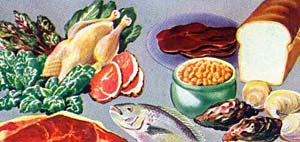 The game encouraged kids to learn about different kinds of nutritious
food.
(Folder 5, Box 28, Defense Council, OSA)
School children played a game called Vita-Min-Go to learn about nutrition during World War II. The game challenged players to eat
a "Victory Diet" every day by playing the game to count the amount of vitamins and minerals they consumed.
The game encouraged kids to learn about different kinds of nutritious
food.
(Folder 5, Box 28, Defense Council, OSA)
School children played a game called Vita-Min-Go to learn about nutrition during World War II. The game challenged players to eat
a "Victory Diet" every day by playing the game to count the amount of vitamins and minerals they consumed.
The game provided players with six colored cards that included a "road to health" with 20 spaces. Each card pertained to a vitamin or mineral such as vitamin C or iron. Players
used the provided score sheet to determine their points based on what they ate for breakfast, lunch
and dinner. Thus, after eating "4 slices of enriched bread during the day, move 4 spaces on the red card, 2 on the purple, and 1 on the yellow." The winner was the first to reach the end of the road on all of the cards.
Play the Game!
 Color cards, score sheet and instructions for Vita-Min-GoFootnote 16
Color cards, score sheet and instructions for Vita-Min-GoFootnote 16
Begun in 1943, the national nutrition campaign entitled "Food Fights for Victory" brought help from media outlets and businesses as well. The campaign, hoping to enhance public support, aimed to tie together several distinct but related programs, such as nutrition, price controls, and Victory Gardens, into one unified concept under the watchwords "Produce, Conserve, Share, Play Square." Langendorf Bakery in Portland commissioned 19 large outdoor panels advertising the campaign while S&W Foods sponsored two more. Meanwhile, the Pacific Railway ran 350 advertising cards inside their train coaches promoting the effort and Portland grocery stores Piggly Wiggly and Safeway ran related advertisements in
The Oregonian and Oregon
Journal newspapers. The radio waves also carried news of the campaign as Portland's KGW ran 55 announcements in less than a month while stations KOIN and KALE ran approximately 45 announcements but also had other coverage: "It has also been mentioned in news stories, and in addition there have been probably 30 mentions of one sort or another."
Footnote 12
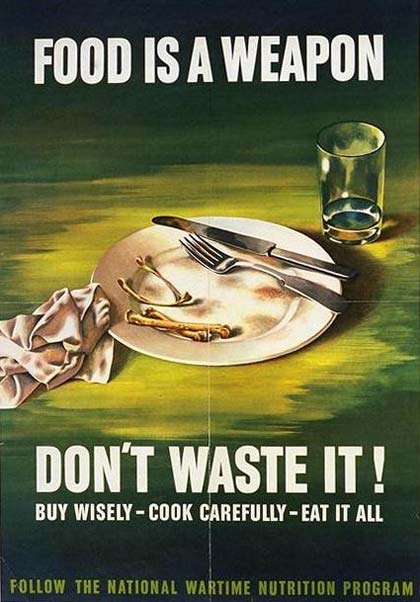 Officials promoted efforts such as the "Clean Plate" campaign to reduce food waste. Don't waste food poster courtesy Northwestern University Library
Officials promoted efforts such as the "Clean Plate" campaign to reduce food waste. Don't waste food poster courtesy Northwestern University Library
Oregonians also took part in other national nutrition campaigns. The "Clean Plate" campaign sought to convince diners to not leave food on their plates, thereby reducing waste and making more food available for the war effort. In 1942 the State Nutrition Committee cooperated with the federal Office of Civilian Defense on the "Share the Meat" campaign. The effort aimed to limit the amount of meat used by consumers so more would be available for the armed services and allies. After meat rationing took effect, state officials decided to end their activities supporting the campaign and instead focus efforts on education related to rationing.
Officials used other means of promoting and educating the public as well. One of the more unusual involved "rat feeding and plant feeding demonstrations." These were to be set up in schools to teach students proper diets. Presumably, one rat would be fed a good diet while another rat would get a bad diet, thereby becoming an object lesson to the children. Experts also recommended "market basket parties, where someone takes the group through a market and points out good buys" as a good way to study purchasing. And officials targeted college groups as being in need of further education, saying that "possibly too much money is spent on social affairs instead of food--'dances, not oranges.'" Nutrition promoters also showed films to spread the word. Oregon State College's Visual Instruction Department offered a number of educational offerings such as "Hidden Hunger," a 20-minute sound film in which the "need for complete feeding of the human body is presented in story form." A 40-minute film intriguingly entitled "Meat and Romance" showed viewers how to buy, cook and carve meats.
Footnote 13Local Activities
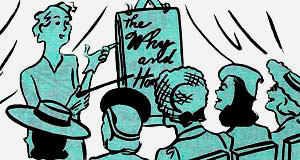 State and local nutrition committee
members gave
talks to local civic groups. (Folder 8, Box 35, Defense Council, OSA)
State and local nutrition committee
members gave
talks to local civic groups. (Folder 8, Box 35, Defense Council, OSA)
Local nutrition advocates across Oregon worked hard to keep nutrition issues in the minds of citizens. Workers in Union County organized a speakers' bureau with nine members. The participants gave a "series of illustrated talks, and demonstrations" to organizations such as granges, parent teacher associations, and Rotary, Lion, and Soroptimist clubs. They also planned window displays, newspaper and radio publicity, and an extensive program in elementary schools that featured distribution of "all three Walt Disney Posters to each school" and giving each school a copy of the Vita -Min-Go nutrition game. Volunteers in Pendleton planned to
set up a nutrition booth in a local place...maybe at the Safeway store. Lane County volunteers continued to promote the school lunch program throughout the county while Klamath County advocates put on a "marionette show, portraying good health habits in relation to good teeth." Noting that 70,000 pressure cookers were scheduled to be made by a cooker company, Klamath officials alerted locals to be ready to place their orders since the county seat's "Sears Roebuck will have 36 pressure cookers." Meanwhile, a Klamath County high school radio group was busy rehearsing their adaptation of a play about proper nutrition to be presented on station KFJI.
Footnote 14